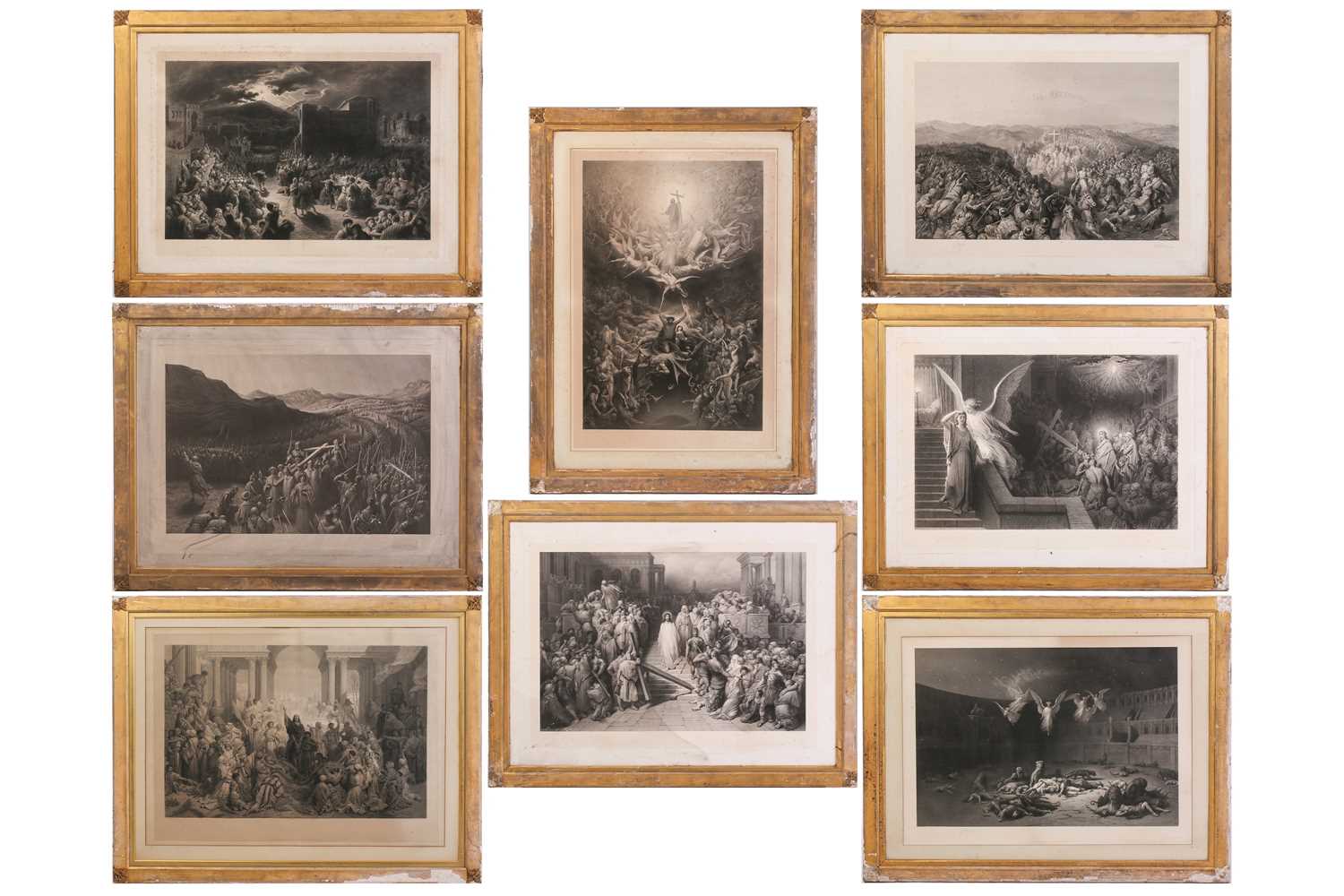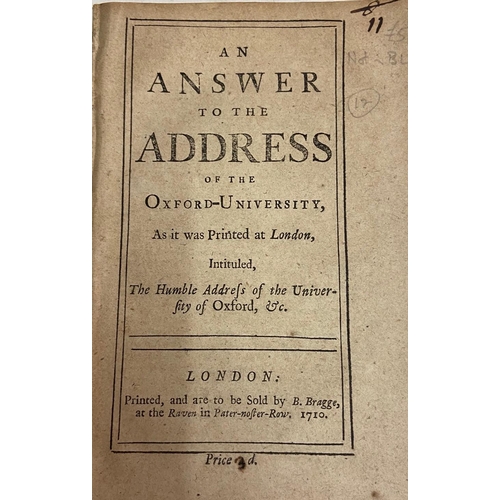THE ‘GOSPELS OF QUEEN THEUTBERGA’ in Latin, ILLUMINATED MANUSCRIPT ON VELLUM [Lotharingia, perhaps Metz, c.825–850 (before 835?)].
THE ‘GOSPELS OF QUEEN THEUTBERGA’ in Latin, ILLUMINATED MANUSCRIPT ON VELLUM [Lotharingia, perhaps Metz, c.825–850 (before 835?)]. 285 x 190 mm. iv + 200 + iv leaves: COMPLETE in 25 gatherings of 8 leaves, foliated in the lower right corner of rectos, ruled in hardpoint for 27 lines of text written in dark brown ink by a single scribe in a handsome Carolingian minuscule with both bowls of ‘g’ open, ascenders slightly clubbed, uncial ‘d’ regularly used at the beginning of a word and sometimes in other positions, ‘et’ abbreviation regularly used for the ampersand and within words, ‘nt’ ligature frequent at ends of lines, written space: 177 x 108 mm, two-line initials throughout painted alternately red and green, FULL-PAGE TITLE AND SIXTEEN DECORATED AND ILLUSTRATED CANON PAGES (some natural flaws in the vellum, some areas discoloured, the edges of the last leaf repaired; on the whole IN EXCEPTIONAL CONDITION ). Blind-tooled white pigskin by Douglas Cockerell, 1933, signed inside lower cover, replacing one by Francis Bedford the spine tooled in gilt capitals ‘Quattuor / Evangelia // MS. Saec. IX.’, gilt edges. PROVENANCE : (1) PROBABLY WRITTEN AT THE BENEDICTINE ABBEY AT METZ OR MURBACH , as suggested by Prof. Bernhard Bischoff on the basis of the script. An 18th-century note in French (f.iv verso) notes that the Feast of All Saints (1 November) is absent from the Capitulary; as it was made a day of obligation throughout the Frankish empire by Louis the Pious ‘at the instance of Pope Gregory IV and with the assent of all the bishops’ in the year 835, this could indicate a terminus ante quem for the writing of the manuscript. (2) Doubtless owned or at least used by an extremely wealthy, even royal, abbess, as suggested by the late 9th-century addition of an Ritual for the Ordination of an Abbess (ff.198v-199), perhaps THE BENEDICTINE ABBEY OF STE-GLOSSINDE , in Metz, the royal capital of Lotharingia. It has long been suggested that the manuscript was used for or by QUEEN THEUTBERGA, WIFE OF LOTHAIRE II, KING OF LORRAINE (d.869), who before 867 became the abbess of Ste-Glossinde, where she was buried. It is likely that she would have bequeathed properties to the sisters upon her death: the present volume may have been among these. (3) Acquired, possibly in the context of Pope Leo IX's patronage of nunneries in the wider Lotharingian and Vosges region, no later than the 11th century by the BENEDICTINE NUNNERY AT POUSSAY , about 60 miles south of Metz, as the added list of rents (ff.199v–200r) are apparently dues to Poussay; the convent was suppressed at the French Revolution. (4) In a ‘ BIBLIOTHÈQUE DES PÈRES DOMINICAINS ’, according to a blue ink-stamp on a 19th-century description in French (f.iv verso). (5) GUGLIELMO LIBRI (1802–1869) , ‘scientist, patriot, scholar, journalist and thief’: his sale at Sotheby’s, 28 March 1859, lot 356 (with engraved illustration), to Tite. Libri called it: ‘ ONE OF THE FINEST MANUSCRIPTS OF THE GOSPELS EVER OFFERED FOR SALE, QUITE COMPLETE, AND IN THE HIGHEST STATE OF PRESERVATION .’ (6) SIR WILLIAM TITE (1798–1873), M.P. and architect; his sale at Sotheby’s, 18 May 1874, lot 1040 ' ONE OF THE MOST ANCIENT AND INTERESTING COPIES OF THE LATIN EVANGELISTS EVER OFFERED FOR SALE' , to Quaritch for £89; Quaritch, Supplement 1875 – 77 to A General Catalogue of Books , 1877, p.3, no 10. (7) ALEXANDER, FIRST LORD PECKOVER OF WISBECH (1830–1919) ; by descent to his daughter Elizabeth (d.1930), who in 1893 married James Doyle Penrose (d.1932); sold then jointly by their sons Alexander and Roland Penrose at Sotheby’s, 3 April 1933, lot 342 (with full-page folding plate), to Quaritch for £540. (8) CHARLES HARRY ST JOHN HORNBY (1867–1946) , his M90, re-bound for him in 1933; signed and dated at Chelsea the same year. (9) MAJOR JOHN ROLAND ABBEY (1894–1969) , with his bookplate, his JA.3229, bought from Hornby’s executors, 15 September 1946; cited in A.R.A. Hobson and A.N.L. Munby, in The Book Colle
THE ‘GOSPELS OF QUEEN THEUTBERGA’ in Latin, ILLUMINATED MANUSCRIPT ON VELLUM [Lotharingia, perhaps Metz, c.825–850 (before 835?)].
THE ‘GOSPELS OF QUEEN THEUTBERGA’ in Latin, ILLUMINATED MANUSCRIPT ON VELLUM [Lotharingia, perhaps Metz, c.825–850 (before 835?)]. 285 x 190 mm. iv + 200 + iv leaves: COMPLETE in 25 gatherings of 8 leaves, foliated in the lower right corner of rectos, ruled in hardpoint for 27 lines of text written in dark brown ink by a single scribe in a handsome Carolingian minuscule with both bowls of ‘g’ open, ascenders slightly clubbed, uncial ‘d’ regularly used at the beginning of a word and sometimes in other positions, ‘et’ abbreviation regularly used for the ampersand and within words, ‘nt’ ligature frequent at ends of lines, written space: 177 x 108 mm, two-line initials throughout painted alternately red and green, FULL-PAGE TITLE AND SIXTEEN DECORATED AND ILLUSTRATED CANON PAGES (some natural flaws in the vellum, some areas discoloured, the edges of the last leaf repaired; on the whole IN EXCEPTIONAL CONDITION ). Blind-tooled white pigskin by Douglas Cockerell, 1933, signed inside lower cover, replacing one by Francis Bedford the spine tooled in gilt capitals ‘Quattuor / Evangelia // MS. Saec. IX.’, gilt edges. PROVENANCE : (1) PROBABLY WRITTEN AT THE BENEDICTINE ABBEY AT METZ OR MURBACH , as suggested by Prof. Bernhard Bischoff on the basis of the script. An 18th-century note in French (f.iv verso) notes that the Feast of All Saints (1 November) is absent from the Capitulary; as it was made a day of obligation throughout the Frankish empire by Louis the Pious ‘at the instance of Pope Gregory IV and with the assent of all the bishops’ in the year 835, this could indicate a terminus ante quem for the writing of the manuscript. (2) Doubtless owned or at least used by an extremely wealthy, even royal, abbess, as suggested by the late 9th-century addition of an Ritual for the Ordination of an Abbess (ff.198v-199), perhaps THE BENEDICTINE ABBEY OF STE-GLOSSINDE , in Metz, the royal capital of Lotharingia. It has long been suggested that the manuscript was used for or by QUEEN THEUTBERGA, WIFE OF LOTHAIRE II, KING OF LORRAINE (d.869), who before 867 became the abbess of Ste-Glossinde, where she was buried. It is likely that she would have bequeathed properties to the sisters upon her death: the present volume may have been among these. (3) Acquired, possibly in the context of Pope Leo IX's patronage of nunneries in the wider Lotharingian and Vosges region, no later than the 11th century by the BENEDICTINE NUNNERY AT POUSSAY , about 60 miles south of Metz, as the added list of rents (ff.199v–200r) are apparently dues to Poussay; the convent was suppressed at the French Revolution. (4) In a ‘ BIBLIOTHÈQUE DES PÈRES DOMINICAINS ’, according to a blue ink-stamp on a 19th-century description in French (f.iv verso). (5) GUGLIELMO LIBRI (1802–1869) , ‘scientist, patriot, scholar, journalist and thief’: his sale at Sotheby’s, 28 March 1859, lot 356 (with engraved illustration), to Tite. Libri called it: ‘ ONE OF THE FINEST MANUSCRIPTS OF THE GOSPELS EVER OFFERED FOR SALE, QUITE COMPLETE, AND IN THE HIGHEST STATE OF PRESERVATION .’ (6) SIR WILLIAM TITE (1798–1873), M.P. and architect; his sale at Sotheby’s, 18 May 1874, lot 1040 ' ONE OF THE MOST ANCIENT AND INTERESTING COPIES OF THE LATIN EVANGELISTS EVER OFFERED FOR SALE' , to Quaritch for £89; Quaritch, Supplement 1875 – 77 to A General Catalogue of Books , 1877, p.3, no 10. (7) ALEXANDER, FIRST LORD PECKOVER OF WISBECH (1830–1919) ; by descent to his daughter Elizabeth (d.1930), who in 1893 married James Doyle Penrose (d.1932); sold then jointly by their sons Alexander and Roland Penrose at Sotheby’s, 3 April 1933, lot 342 (with full-page folding plate), to Quaritch for £540. (8) CHARLES HARRY ST JOHN HORNBY (1867–1946) , his M90, re-bound for him in 1933; signed and dated at Chelsea the same year. (9) MAJOR JOHN ROLAND ABBEY (1894–1969) , with his bookplate, his JA.3229, bought from Hornby’s executors, 15 September 1946; cited in A.R.A. Hobson and A.N.L. Munby, in The Book Colle










/71967/Internet%20Image%201.jpg)


Testen Sie LotSearch und seine Premium-Features 7 Tage - ohne Kosten!
Lassen Sie sich automatisch über neue Objekte in kommenden Auktionen benachrichtigen.
Suchauftrag anlegen